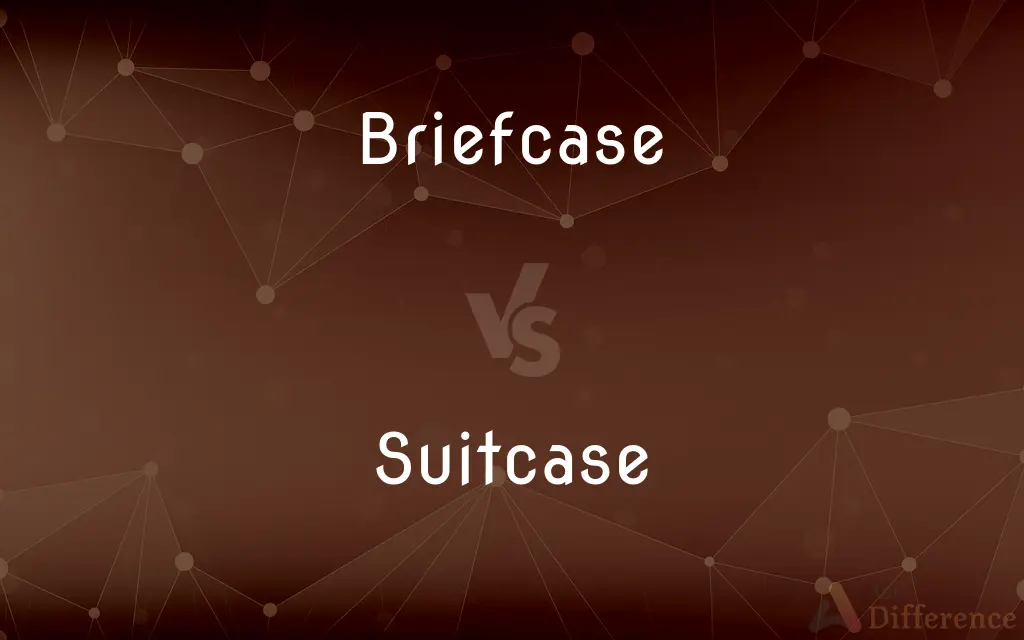Briefcase vs. Suitcase — What's the Difference?
By Fiza Rafique & Maham Liaqat — Updated on March 7, 2024
A briefcase is designed for carrying documents and small items for business, showcasing a professional look, whereas a suitcase is used for personal belongings during travel, often larger and more varied in design.

Difference Between Briefcase and Suitcase
Table of Contents
ADVERTISEMENT
Key Differences
Briefcases and suitcases serve different primary functions based on the needs of the user. A briefcase is typically used for carrying documents, laptops, and other necessities for work or business meetings. It emphasizes a professional appearance and is designed to organize and protect important papers and electronic devices. On the other hand, a suitcase is primarily used for personal belongings while traveling. It comes in various sizes and is built to hold clothes, toiletries, and other travel essentials for days or weeks away from home.
The design of a briefcase is usually slim and structured, with compartments for organizing items such as pens, business cards, and files, ensuring they are easily accessible. This contrasts with the suitcase, which features a larger, more spacious design to accommodate a greater volume of items. Suitcases often have features like wheels and telescopic handles for easy transport, especially when heavy or being used in airports or train stations.
Material-wise, briefcases are commonly made from leather or high-quality synthetic materials, giving them a sleek and professional look suitable for business environments. Suitcases, however, are made from a wider range of materials, including hardshell plastics for durability and protection against impacts, as well as soft materials like fabric for flexibility and expandability.
In terms of usage context, briefcases are a staple in professional settings and are often carried to offices, business meetings, or formal events. They are a symbol of professionalism and are used by individuals who need to transport work-related materials. Suitcases are used for personal travel, whether for business trips, vacations, or visits, and are designed to withstand the rigors of travel, including handling by airlines and other transportation services.
While both items are essential for carrying belongings, the choice between a briefcase and a suitcase depends on the type of items being transported, the occasion, and the user's needs for organization, appearance, and functionality.
ADVERTISEMENT
Comparison Chart
Primary Use
Carrying documents and business essentials
Transporting personal belongings for travel
Design
Slim, structured, with compartments for organization
Larger, with a focus on capacity and easy transport
Material
Leather or high-quality synthetics
Variety, including hardshell plastics and fabrics
Features
Organizational compartments, sometimes with locks
Wheels, telescopic handles, expandable sections
Usage Context
Professional settings, business meetings
Personal travel, including vacations and business trips
Compare with Definitions
Briefcase
Designed for carrying business documents and essentials.
He carried a leather briefcase to the meeting.
Suitcase
Used for carrying personal items while traveling.
They packed their clothes and toiletries in a large suitcase.
Briefcase
Slim and structured for organization.
His briefcase contained compartments for documents, a laptop, and pens.
Suitcase
Comes in various sizes and designs.
Her hardshell suitcase protected her belongings during the flight.
Briefcase
Symbolizes professionalism in work settings.
A briefcase is a common accessory for lawyers and business professionals.
Suitcase
Features like wheels and handles for transport.
The suitcase's telescopic handle made it easy to navigate through the airport.
Briefcase
Emphasizes a professional appearance.
Her briefcase was neatly organized with all her presentation materials.
Suitcase
Designed for durability and capacity.
Their expandable suitcase could accommodate souvenirs from their travels.
Briefcase
Often made from leather or synthetic materials.
The executive's briefcase was crafted from fine Italian leather.
Suitcase
Essential for personal travel needs.
Before each trip, he meticulously organizes his suitcase.
Briefcase
A briefcase is a narrow hard-sided box-shaped bag or case used mainly for carrying papers and equipped with a handle. Lawyers commonly use briefcases to carry briefs to present to a court, hence the name.
Suitcase
A suitcase is a form of luggage. It is often a somewhat flat, rectangular-shaped bag with rounded square corners.
Briefcase
A portable, often flat case with a handle, used for carrying papers or books.
Suitcase
A usually rectangular piece of luggage for carrying clothing.
Briefcase
A case used for carrying documents, especially for business.
Suitcase
A large (usually rectangular) piece of luggage used for carrying clothes, and sometimes suits, when travelling.
My suitcase is stowed in the luggage rack.
Briefcase
(computing) In Microsoft Windows, a folder that supports file synchronization between itself and another folder.
Suitcase
To trade using samples in a suitcase.
Briefcase
A small suitcase with a handle; it is used for carrying papers or files or books.
Suitcase
To smuggle in one's rectum.
Briefcase
A case with a handle; for carrying papers or files or books
Suitcase
A portable rectangular traveling bag for carrying clothes;
He carried his small bag onto the plane with him
Common Curiosities
What distinguishes a briefcase from a suitcase?
A briefcase is designed for carrying business documents and essentials with a professional appearance, while a suitcase is for personal belongings during travel, emphasizing capacity and transport ease.
Can a briefcase be used for travel?
Yes, a briefcase can be used for travel, especially for carrying work-related items, but it's less suitable for personal belongings or extended trips.
How have briefcases evolved over time?
Briefcases have evolved to include modern features like laptop compartments and improved locking mechanisms, catering to contemporary professional needs.
Are all suitcases equipped with wheels?
While many modern suitcases have wheels for convenience, not all do. The presence of wheels depends on the design and purpose of the suitcase.
Do briefcases and suitcases come in standard sizes?
Both come in various sizes, but briefcases are generally smaller and more structured, while suitcases range from carry-on to large, checked luggage sizes.
Is it common for professionals to travel with both a briefcase and a suitcase?
Yes, professionals often travel with both, using the briefcase for work essentials and the suitcase for personal items.
Can a suitcase serve as a briefcase?
Suitcases are not typically used as briefcases due to their larger size and different organizational features, but small suitcases might be used for carrying work materials on business trips.
Why are briefcases often made of leather?
Leather is durable and conveys a professional look, making it a preferred material for briefcases used in business environments.
Can technology be incorporated into briefcases and suitcases?
Yes, modern versions may include features like built-in power banks, solar panels, and security locks with fingerprint recognition.
How do cultural differences affect the use of briefcases and suitcases?
Cultural differences can influence the style, size, and material preference for briefcases and suitcases based on local business practices and travel habits.
How should one choose between a briefcase and a suitcase?
The choice depends on the purpose: a briefcase for business and professional use, and a suitcase for personal travel and carrying more items.
Are there environmentally friendly options for briefcases and suitcases?
Yes, there are eco-friendly options made from sustainable materials like recycled plastics and natural fibers.
What role do aesthetics play in the choice of briefcases and suitcases?
Aesthetics can significantly influence choice, with individuals selecting options that reflect their personal style and the image they wish to project.
What is the future of briefcase and suitcase design?
Future designs are likely to emphasize sustainability, technology integration, and adaptability to changing work and travel environments.
What advancements have been made in suitcase design?
Suitcases have seen innovations like lightweight materials, 360-degree wheels, and smart features like GPS tracking and USB charging ports.
Share Your Discovery

Previous Comparison
Fraternity vs. Sorority
Next Comparison
Tear vs. CryAuthor Spotlight
Written by
Fiza RafiqueFiza Rafique is a skilled content writer at AskDifference.com, where she meticulously refines and enhances written pieces. Drawing from her vast editorial expertise, Fiza ensures clarity, accuracy, and precision in every article. Passionate about language, she continually seeks to elevate the quality of content for readers worldwide.
Co-written by
Maham Liaqat













































